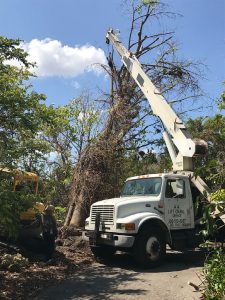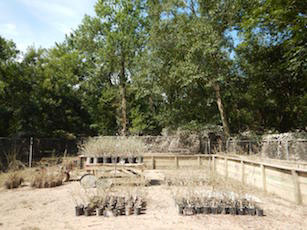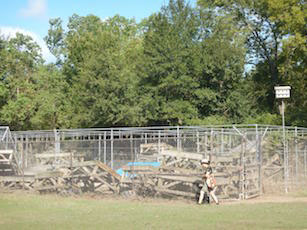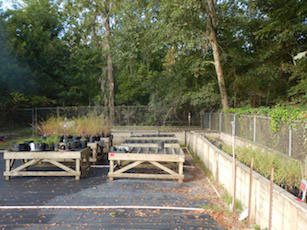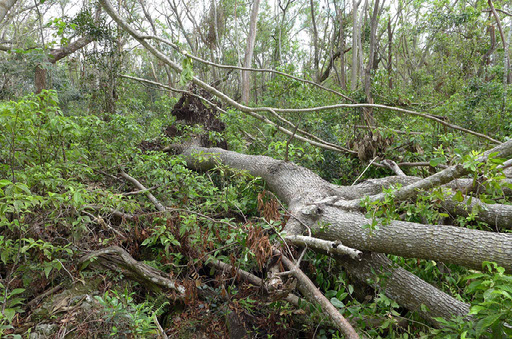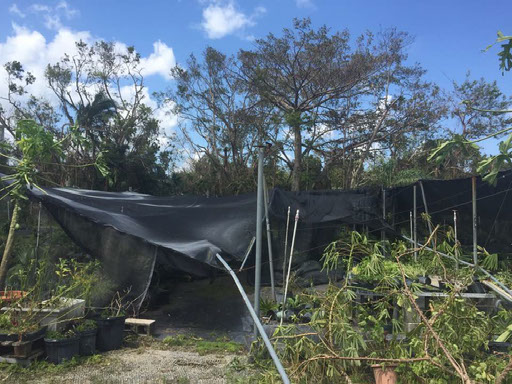Do Storm Events Trigger Seedlings?
“Fairchild Tropical Botanic Garden staff, with the assistance of many volunteers and land managers, transplanted hundreds of plants of the U.S. endangered Beach Jacquemontia (Jacquemontia reclinata) into suitable habitats along the eastern coast of Florida in an effort to reduce its risk of extinction. Since 2001, they have monitored the health and persistence of 19 Beach Jacquemontia reintroductions. When big weather events happen, they can make comparisons to previous years. Following heavy rains in 2011, one site experienced knee-deep freshwater flooding. The next year swells generated by Hurricane Sandy inundated Beach Jacquemontia with saltwater. At first glance, it looked very bad for the rare plant populations. Yet after these events, bountiful numbers of seedlings emerged. We hope that in time similar good outcomes emerge from recent storm events.” (Joyce Maschinski)
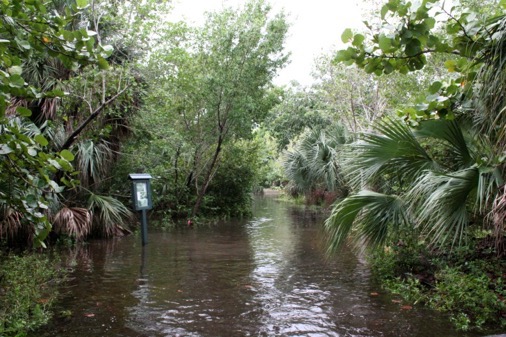
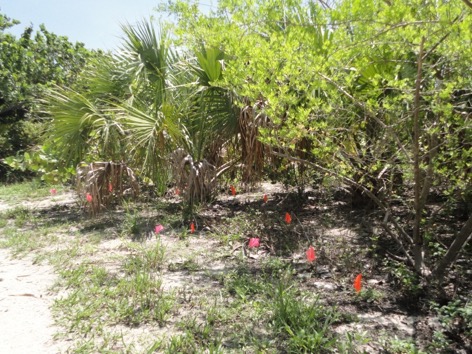
Eastern Coast of Florida. Left: Flooding in 2011 after heavy rains; Right: New seedlings of Jacquemontia reclinata
Next, we reached out to some of our CPC gardens and they took the time to share their stories.
Bok Tower Gardens, Lake Wales, Florida
“While Hurricane Irma did not cause the level of damage experienced by the hurricanes of 2004, the Gardens had extensive tree damage, lost several big trees, and was a big mess from fallen branches, twigs and Spanish moss. We also had an extended power outage due to the loss of 14 power poles which had to be replaced and rewired. Staff from all departments and volunteers from throughout central Florida worked for nine days on cleanup of the grounds. Professional tree crews were called in to assess the damage, remove the larger fallen trees and confirm paths were safe for visitor traffic. We also lost some panels in the greenhouse, and the strong winds caused some water intrusion through one of the large Founder’s Room windows located on the side of the Tower. However, thankfully the furniture was covered minimizing the potential damage to the irreplaceable antiques. The National Collection came through very well. A large limb broke off an old Asimina tetramera and an old Ziziphus celata, but both plants will easily recover. A tall pine in the National Collection beds fell, but happily missed the irrigation lines and plant specimens. We obtained a generator for the seed storage facilities years ago, for just such an event like this hurricane, and because of that the seed storage facilities retained their temperature and had no losses.” (Cheryl L. Peterson)
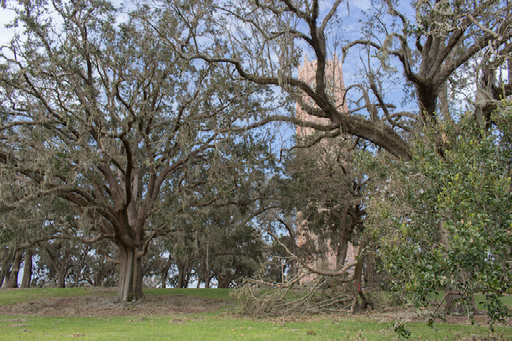
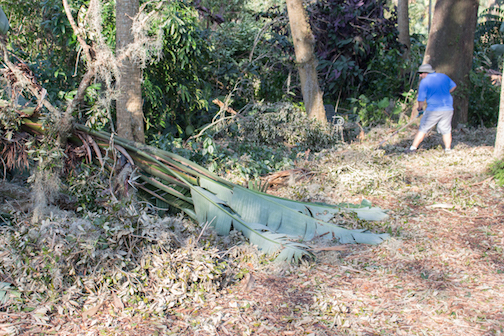

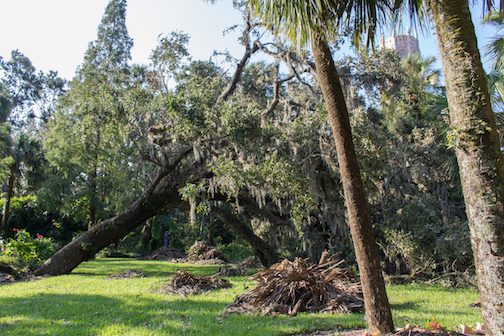
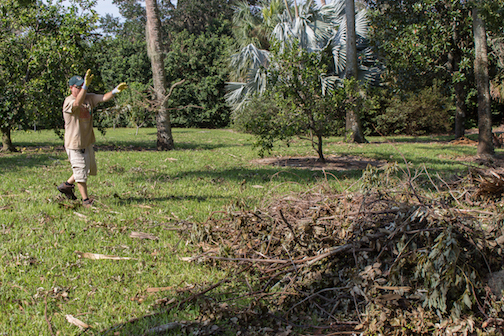
Montgomery Botanical Center, Coral Gables, Florida
“Hurricane Irma brought fast winds, heavy rains, high seas, and extensive damage to Montgomery on September 9 and 10. The initial post-hurricane scene was shocking: oaks were downed, broken, or uprooted; Royal Palms stood bare of fronds; beloved Champion Trees lay prone or stood shattered; and garden paths were dense and tangled from the windfalls. Assessment of the damage began quickly following the storm, balanced with cutting and hauling of trunks and limbs. At last count, we are working to save 109 palms, but we also must say goodbye to at least 150 more – and we are still counting. Months of work lie ahead, but the team is up to the task and will continue to move forward with recovery and tending this changed but still beautiful garden.” (Joanna Lima)
Damage and Clean Up, Montgomery Botanical Center
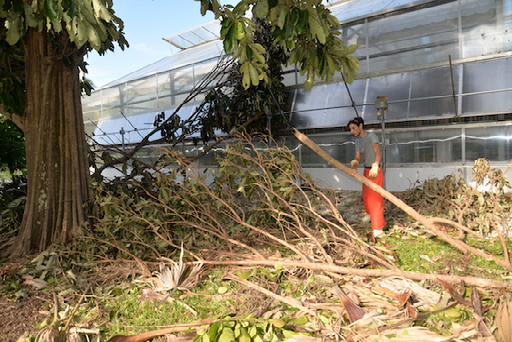

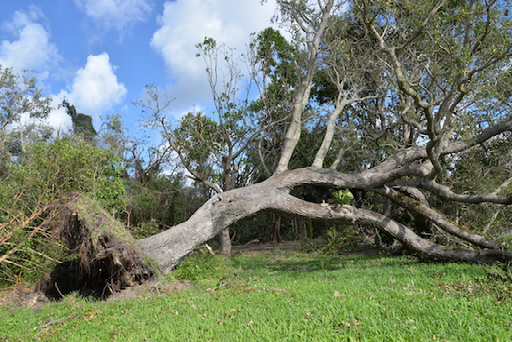
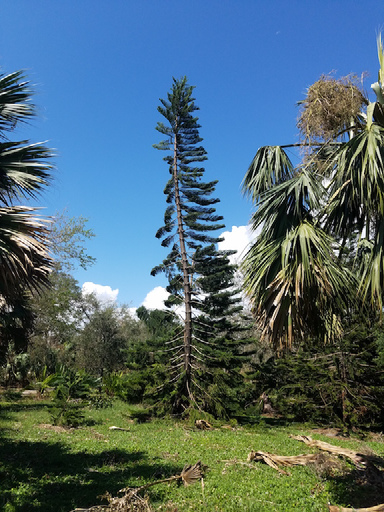
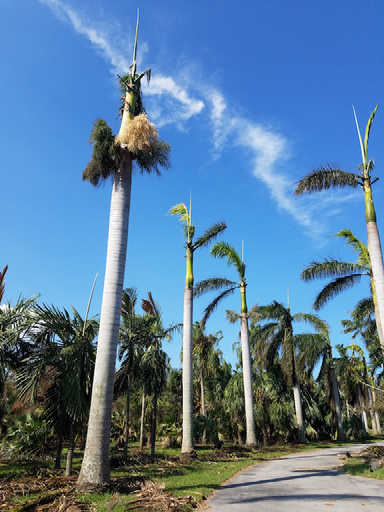
Mercer Botanic Gardens, Humble, Texas
“Flooding greatly impacted parts of Mercer. Both the CPC Conservation Nursery and the Mercer Endangered Species and Native Plant Garden experienced 8-10 feet plus of flood water. Rainfall in the area ranged from 35-50” during the course of Hurricane Harvey. Luckily, the National Collection of plants suffered minimal damage even though potted plants sat underwater for about 5 days, or floated over the 8-9’ fence around the nursery! Yet there was minimal loss of conservation nursery restoration stock. Some Phlox nivalis and Silene subciliata plants suffered loss, while others are recovering and look fine, including Hibiscus dasycalyx, Physostegia correllii, and Isoetes louisianensis.
“Floodwater flowed over Mercer Endangered Species and Native Plant Garden for about 5 days. A few educational display plants succumbed, while others show promise of recovery. Both Yucca cernua and Leitneria floridana lost foliage but are re-sprouting leaves. Mercer garden staff, education staff, and volunteer coordinators are still cleaning up the Endangered Species and Native Garden.
“The Mercer Botanical Center, the research facility, received about 8” of flood water. The building has a standby generator. There was no loss at the Seed Bank. Even though freezers had water below the units, they still work. The Seed Bank has since been moved to freezer units on the second floor of the building. Herbarium collections on the second floor received no damage, and only a few books were lost from the library collections.
“Prairie Dawn Preserve does not look like any unusual flooding took place on the property. Some erosion is taking place near the fence line. Rayjacksonia aurea, Chloris texensis and Liatris bracteata are starting to bloom. Other fall blooming prairie plants look amazing, too!
“We applaud the immediate support received from Harris County Precinct 4 facilities/building maintenance, Mercer staff and IT department who completed post-flood repair of A/C units, removed damaged drywall, relocated offices upstairs, removed debris, and relocated computer workstations. Mercer volunteers have been assisting throughout by removing debris and cleanup, boxing and moving the library collection upstairs, continuing assistance at the Prairie Dawn Preserve and the conservation nursery. No building repairs have yet taken place.
Mercer’s conservation staff, unfortunately, have much experience with pre-hurricane/flood/wind disaster maintenance strategies for the CPC collections, thus suffered minimal loss due to our maintenance protocols, and diligent post flood cleanup of nursery stock. These plants are flood-resilient!
“Mercer, with almost 400 acres, will be closed for some time as recovery continues. Dr. Raven and Dr. Wyse Jackson are to be commended for donating skilled gardeners and staff, equipment, materials and snacks to assist and keep up our spirits. The gardeners rebuilt the two-story staff building’s stairway, destroyed by a fallen sweetgum tree. Missouri Botanical Garden horticulturists assisted Mercer’s greenhouse manager with restoring the production nursery. We appreciate receiving many encouraging emails and calls from our CPC family across the network!” (Anita Tiller)
Mercer Botanic Gardens – Before and After
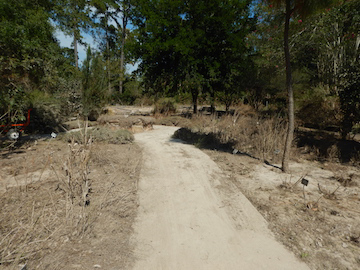
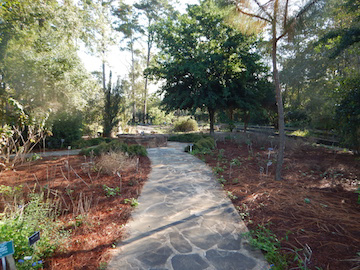
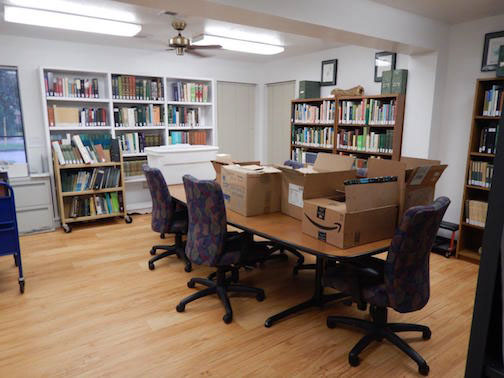
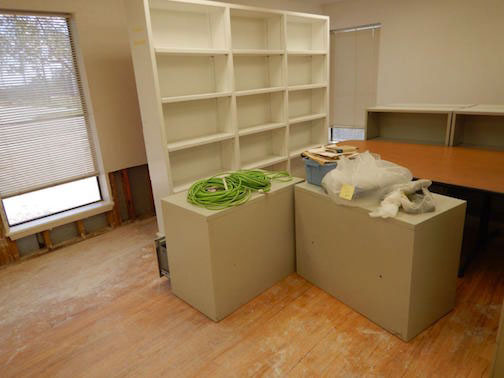
Endangered Species and Native Garden after flood …and today (top). Mercer Botanical Center Library before Hurricane Harvey Flood and after (bottom). Photos by Suzzanne Chapman

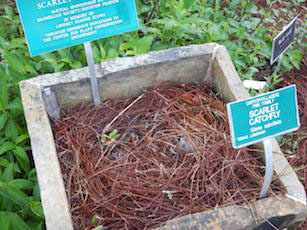
Mercer Botanic Gardens Endangered Species and Native Plant Garden. Display of Silene subciliata after flood and today’s regrowth. Photos by Suzzanne Chapman
Fairchild Tropical Botanic Garden, Coral Gables, Florida
“Overall, Fairchild’s CPC National Collection came through Hurricane Irma very well. We were lucky – we did not lose any plants in the nursery. We are not aware of any losses of National Collection plants in the garden. However, a full inventory has not yet been conducted and negative effects from storm surge may happen gradually over weeks. Most of the National Collection plants are in the “lowlands,” which appeared to have experienced a storm surge of 2 feet or more. The National Collection seems more important now than ever, as we are very concerned about the status of these taxa in the wild. Specifically, the greatest concerns include all taxa which are native to Puerto Rico and the U.S. Virgin Islands, all taxa that are found in the Florida Keys, and the Florida native ferns which are restricted to closed-canopy forests called rockland hammock.
“After checking the status of our National Collection at our garden, we went into the field and assessed how the wild populations of these rare and endangered plants fared.
• In the Caribbean: Fairchild doesn’t expect to know how the 24 Caribbean taxa fared for some time.
• In the Florida Keys: Strong winds and storm surge threatened seven Florida Keys taxa. With land managers, Fairchild staff made several trips to assess damage and rescue broken, salt-soaked pieces of Key Tree Cactus (Pilosocereus robinii). Removing fallen trees and debris that directly impacted cacti, we took cuttings from plants in precarious conditions to safeguard germplasm. Monitoring reintroduced populations of Pilosocereus robinii, Consolea corallicola, and Pseudophoenix sargentii revealed some losses, but the populations remain intact. Luckily, Fairchild conducted a CPC-funded seed collection trip in 2016 to safeguard material of all three species. Appreciation goes out to all of our partners and volunteers that helped with these efforts.
• All five of our Miami fern species that are part of the National Collection are found in closed-canopy rockland hammocks. Hurricanes may cause trees to fall on small populations of ferns, or create dramatically more sunlight that can kill plants. Our staff hit the ground after the storms to assess almost all wild populations of these ferns. We expect that some populations (especially Asplenium verecundum and Trichomanes punctatum ssp. floridanum) will be negatively impacted, but all should recover in time.” (James Lange and Jennifer Possley)
Damage and Clean Up – Fairchild Tropical Botanic Garden
The Kampong, The National Tropical Botanical Garden, Miami, Florida
“Unfortunately, Hurricane Irma inflicted serious damage to our living collections and the storm surge and wind-driven waves ripped away the soil and plants from the point that looks into Biscayne Bay and tossing up coral boulders and rubble in a swath of destruction that is hard to imagine. On Saturday, while I was there, we were able to complete a survey of the damage to the accessioned trees in our collections, some of which date back 100 years to when Fairchild bought the property. Two-hundred and sixty trees were impacted by Irma’s winds, which lasted more than 10 hours. Of these, 24 are dead with no hope of recovery. Another 68 were uprooted and thrown to the ground. Of the trees that were not toppled, 146 have significant canopy damage and 22 have moderate canopy damage. It will take years of regular arborist work to restore any sense of architectural integrity to the surviving trees. While the devastation is widespread and difficult to comprehend, all of our structures came through without significant damage and the team at The Kampong, led by Director Craig Morrell, have been amazing in their recovery effort. Within hours of the storm ending, Mike Maunder, who is now at the Eden Project in the U.K., had made arrangements for their arborist to fly to Miami and help us. He has been invaluable and when he leaves we will miss not only his skills but his incredible attitude and work ethic. Working around the clock for the past 14 days, our team has made tremendous progress and tomorrow a 100-ton crane will arrive to stand up the 15-ton Baobab tree that is 100 years old. When we left on Monday to fly home, all around us were signs of hope and resilience and the noise of passionate, hard-working people laboring to save these precious plants before they die from roots exposed to the scorching heat. We will recover … but it will be a long and expensive process, and as I made the long flight back to Hawaii, it left me thinking seriously about how we make our gardens more resilient in the face of climate change, which will bring more extreme weather events to all of the regions that are gardens are located in.” (Chipper Wichman)
Photos by Heidi Whitman
